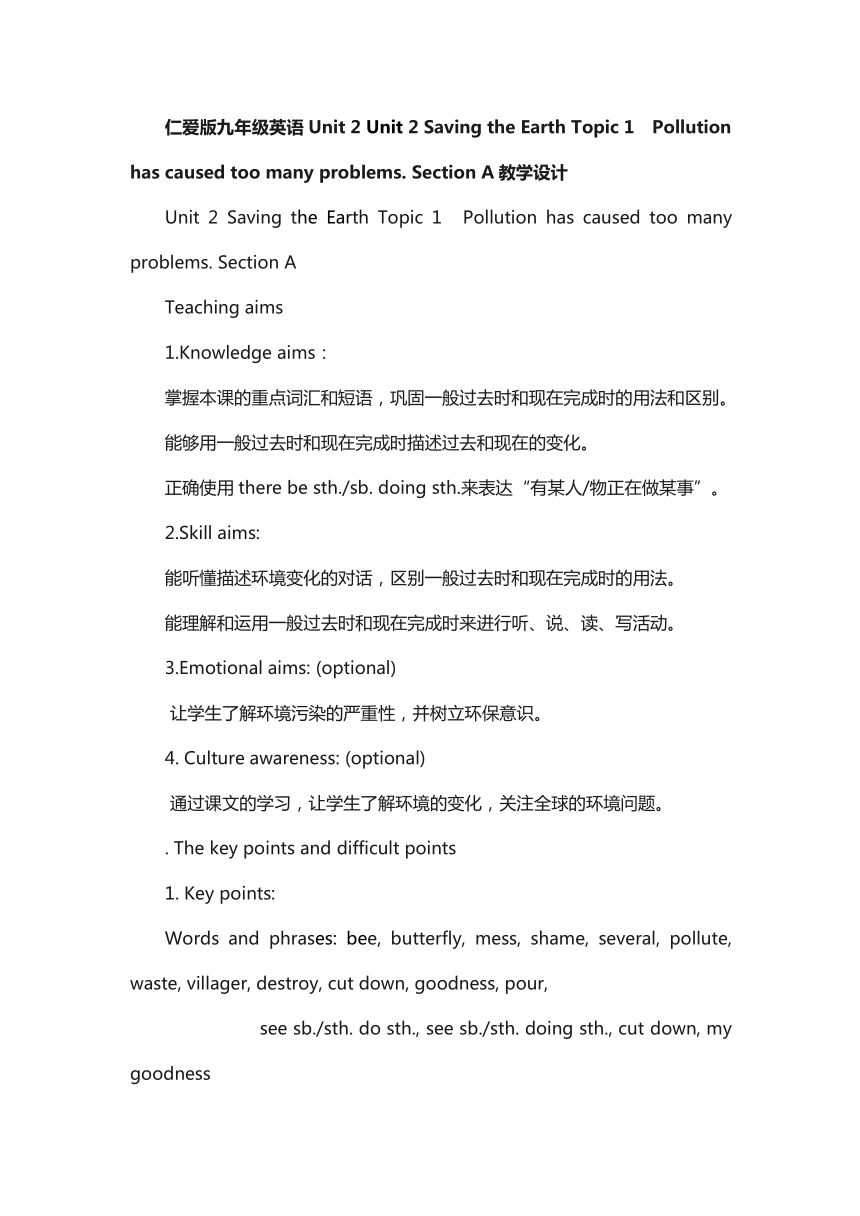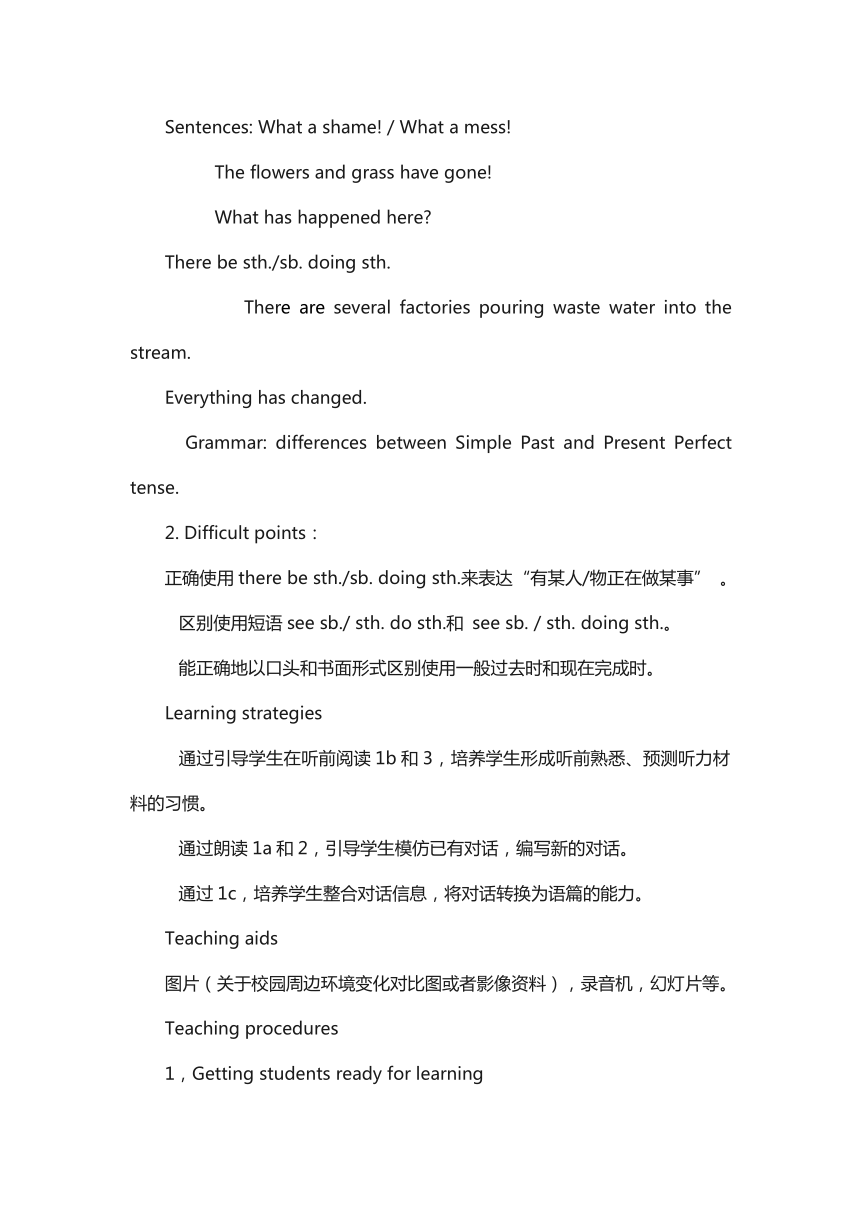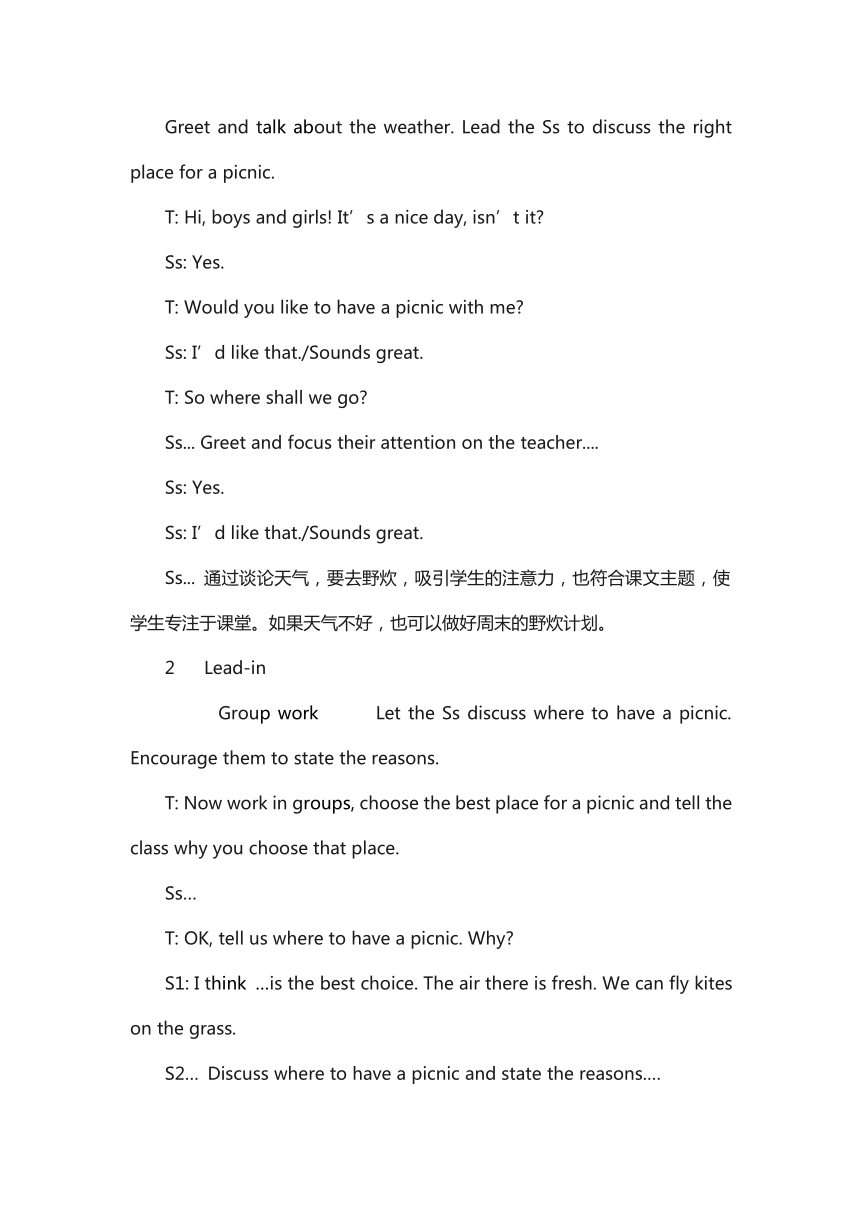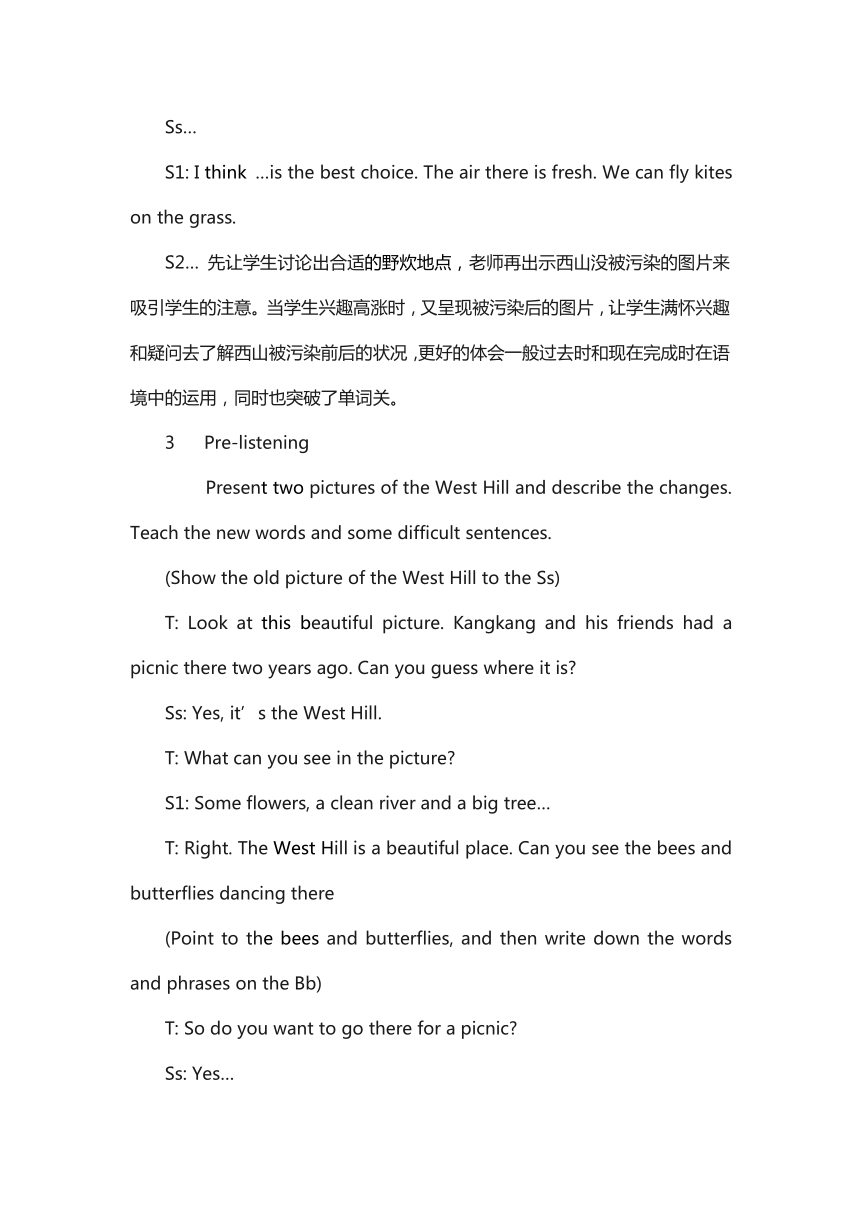仁爱版九年级英语Unit 2 Saving the Earth Topic 1 Pollution has caused too many problems教学设计
文档属性
| 名称 | 仁爱版九年级英语Unit 2 Saving the Earth Topic 1 Pollution has caused too many problems教学设计 |  | |
| 格式 | zip | ||
| 文件大小 | 122.1KB | ||
| 资源类型 | 教案 | ||
| 版本资源 | 仁爱科普版 | ||
| 科目 | 英语 | ||
| 更新时间 | 2017-07-23 06:44:29 | ||
图片预览




文档简介
仁爱版九年级英语Unit
2
Unit
2
Saving
the
Earth
Topic
1
Pollution
has
caused
too
many
problems.
Section
A教学设计
Unit
2 Saving
the
Earth
Topic
1
Pollution
has
caused
too
many
problems.
Section
A
Teaching
aims
1.Knowledge
aims:
掌握本课的重点词汇和短语,巩固一般过去时和现在完成时的用法和区别。
能够用一般过去时和现在完成时描述过去和现在的变化。
正确使用there
be
sth./sb.
doing
sth.来表达“有某人/物正在做某事”。
2.Skill
aims:
能听懂描述环境变化的对话,区别一般过去时和现在完成时的用法。
能理解和运用一般过去时和现在完成时来进行听、说、读、写活动。
3.Emotional
aims:
(optional)
让学生了解环境污染的严重性,并树立环保意识。
4.
Culture
awareness:
(optional)
通过课文的学习,让学生了解环境的变化,关注全球的环境问题。
.
The
key
points
and
difficult
points
1.
Key
points:
Words
and
phrases:
bee,
butterfly,
mess,
shame,
several,
pollute,
waste,
villager,
destroy,
cut
down,
goodness,
pour,
see
sb./sth.
do
sth.,
see
sb./sth.
doing
sth.,
cut
down,
my
goodness
Sentences:
What
a
shame!
/
What
a
mess!
The
flowers
and
grass
have
gone!
What
has
happened
here
There
be
sth./sb.
doing
sth.
There
are
several
factories
pouring
waste
water
into
the
stream.
Everything
has
changed.
Grammar:
differences
between
Simple
Past
and
Present
Perfect
tense.
2.
Difficult
points:
正确使用there
be
sth./sb.
doing
sth.来表达“有某人/物正在做某事”
。
区别使用短语see
sb./
sth.
do
sth.和
see
sb.
/
sth.
doing
sth.。
能正确地以口头和书面形式区别使用一般过去时和现在完成时。
Learning
strategies
通过引导学生在听前阅读1b和3,培养学生形成听前熟悉、预测听力材料的习惯。
通过朗读1a和2,引导学生模仿已有对话,编写新的对话。
通过1c,培养学生整合对话信息,将对话转换为语篇的能力。
Teaching
aids
图片(关于校园周边环境变化对比图或者影像资料),录音机,幻灯片等。
Teaching
procedures
1,Getting
students
ready
for
learning
Greet
and
talk
about
the
weather.
Lead
the
Ss
to
discuss
the
right
place
for
a
picnic.
T:
Hi,
boys
and
girls!
It’s
a
nice
day,
isn’t
it
Ss:
Yes.
T:
Would
you
like
to
have
a
picnic
with
me
Ss:
I’d
like
that./Sounds
great.
T:
So
where
shall
we
go
Ss...
Greet
and
focus
their
attention
on
the
teacher....
Ss:
Yes.
Ss:
I’d
like
that./Sounds
great.
Ss...
通过谈论天气,要去野炊,吸引学生的注意力,也符合课文主题,使学生专注于课堂。如果天气不好,也可以做好周末的野炊计划。
2
Lead-in
Group
work
Let
the
Ss
discuss
where
to
have
a
picnic.
Encourage
them
to
state
the
reasons.
T:
Now
work
in
groups,
choose
the
best
place
for
a
picnic
and
tell
the
class
why
you
choose
that
place.
Ss…
T:
OK,
tell
us
where
to
have
a
picnic.
Why
S1:
I
think
…is
the
best
choice.
The
air
there
is
fresh.
We
can
fly
kites
on
the
grass.
S2…
Discuss
where
to
have
a
picnic
and
state
the
reasons.…
Ss…
S1:
I
think
…is
the
best
choice.
The
air
there
is
fresh.
We
can
fly
kites
on
the
grass.
S2…
先让学生讨论出合适的野炊地点,老师再出示西山没被污染的图片来吸引学生的注意。当学生兴趣高涨时,又呈现被污染后的图片,让学生满怀兴趣和疑问去了解西山被污染前后的状况,更好的体会一般过去时和现在完成时在语境中的运用,同时也突破了单词关。
3
Pre-listening
Present
two
pictures
of
the
West
Hill
and
describe
the
changes.
Teach
the
new
words
and
some
difficult
sentences.
(Show
the
old
picture
of
the
West
Hill
to
the
Ss)
T:
Look
at
this
beautiful
picture.
Kangkang
and
his
friends
had
a
picnic
there
two
years
ago.
Can
you
guess
where
it
is
Ss:
Yes,
it’s
the
West
Hill.
T:
What
can
you
see
in
the
picture
S1:
Some
flowers,
a
clean
river
and
a
big
tree…
T:
Right.
The
West
Hill
is
a
beautiful
place.
Can
you
see
the
bees
and
butterflies
dancing
there
(Point
to
the
bees
and
butterflies,
and
then
write
down
the
words
and
phrases
on
the
Bb)
T:
So
do
you
want
to
go
there
for
a
picnic
Ss:
Yes…
T:
I’d
like
to.
But
now
it
has
changed
a
lot.
Look
at
this
picture.
Do
you
like
it
Ss:
No.
(Teacher
presents
the
new
words
and
difficult
sentences
through
the
description
of
the
picture.)
Watch
the
pictures
of
the
West
Hill,
guess
the
meaning
and
pronunciation
of
the
words
according
to
the
introduction
about
the
changes
of
the
West
Hill.
Ss:
Yes,
it’s
the
West
Hill.…
S1:
Some
flowers,
a
clean
river
and
a
big
tree……
Ss:
Yes……
Ss:
No.
在教授新单词时,老师应当同时呈现单词和音标,让学生运用所学音标自己解决单词的读音问题,如果学生发音不准,老师要及时更正。再根据图片和讲解,引导学生大胆的猜测词义和部分难句的意思,为1a中的听力对话扫障碍。
4
While-listening
Group
work
Step
1:
Let
the
Ss
listen
to
1a
twice
and
do
1b
alone.
T:
Listen
to
the
tape
carefully
and
try
to
mark
the
words
with
P
or
N.
…
T:
Now
please
check
answers
in
your
group.
S1:
“Beautiful”
is
in
the
past.
S2:“Butterflies”
are
in
the
past.
S3:
“Dirty”
is
now.…
Step
2:
Let
the
Ss
listen
to
1a
again
and
pay
attention
to
the
pronunciation
and
the
intonation.
Then
practice
1a
in
groups
and
role
play
it.
T:
Read
1a
with
your
group
members
and
act
it
out.
Listen
and
mark
the
words
with
P
or
N
according
to
the
tape.
.
S1:
“Beautiful”
is
in
the
past.
S2:“Butterflies”
are
in
the
past.
S3:“Dirty”
is
now.…
Listen
to
1a
again
and
pay
attention
to
the
pronunciation
and
the
intonation.
Then
practice
1a
in
groups
and
role
play
it.
本课对话不长,词汇量不大,可以直接在组内核对答案。如果对话较长,难度较大,建议先听两遍后再读,通过读来检查听的结果。
分角色朗读是培养语感,增强自信,提高兴趣的基本方法之一。让学生通过读的方式感知一般过去时和现在完成时的差别后,在2中马上运用,编写新的对话,可以让学生完整的体会两种时态的区别,也突破了本课的语法关。
5
Post-listening
Step
1:
Let
the
Ss
read
1a
aloud
and
fill
the
blanks
in
1c
in
groups.
T:
Read
1a
aloud
and
fill
in
the
blanks
in
1c
as
quickly
as
possible,
and
then
discuss
the
answer
with
your
group
members.…
T:
Now
check
the
answer
together.
S1:
a
beautiful
place
S2:
lost
of
flowers
and
grass
S3:
…
Step2:
Let
the
Ss
observe
the
pictures
and
study
the
example
in
2
and
try
to
make
new
dialogs
according
to
the
pictures
and
the
given
words.
Then
act
out
the
dialogs.
T:
Now
study
the
example
in
2
and
try
to
make
new
dialogs
with
their
partners
according
to
the
pictures
and
the
given
words.
Then
act
out
the
dialogs.…
T:
OK,
who
can
try
S1:
There
were
many
trees
when
I
visited
the
hill
last
year.
S2:
But
now
the
trees
have
gone.
S1:
What
has
happened
here
S2:
The
farmers
have
cut
them
down.…
Step
3:
Lead
the
Ss
to
look
at
the
pictures
and
listen
to
the
sentences
once
to
number
them.
Then
listen
to
them
twice
to
complete
the
sentences.
T:
Look
at
these
pictures
in
3,
listen
and
number
them....
T:
OK,
now
check
the
answers
together.
The
right
order
is…
T:
Well
done.
Now
listen
again
and
fill
in
the
blanks
in
3.
When
listening,
you
can
only
write
the
first
two
letters
of
each
word
or
the
first
word
of
each
phrase.
After
finishing
listening,
you
have
some
time
to
complete
your
answers.
Ready …
T:
OK.
Now
you
have
one
minute
to
complete
the
sentence.
Pay
attention
to
the
form
of
verbs.…
T:
OK,
time
is
up.
Let’s
check
the
answers.
S1:
People
have
cut
down
too
many
trees.
S2:
…many
trees….
S3:
…but
now
they
…
S4…
Read
and
fill
the
blanks
in
1c
as
quickly
as
possible.
S1:
a
beautiful
place
S2:
lost
of
flowers
and
grass
S3…
Observe
the
pictures
and
study
the
example
in
2
and
try
to
make
new
dialogs
with
their
partners
according
to
the
pictures
and
the
given
words.
Then
act
out
the
dialogs.
S1:
There
were
many
trees
when
I
visited
the
hill
last
year.
S2:
But
now
the
trees
have
gone.
S1:
What
has
happened
here
S2:
The
farmers
have
cut
them
down.
Look
at
the
pictures
and
listen
to
the
sentences
once
to
number
them.
Then
listen
to
them
twice
and
complete
the
sentences.
S1:
People
have
cut
down
too
many
trees.
S2:
…many
trees….
S3:
…but
now
they
…
S4…
做完听力练习后,再让学生通过读的方式在具体情况中感知两种时态的差别,并通过相应的任务去掌握它们的用法。
该环节是让学生通过听的方式,继续学习一般过去时和现在完成时的区别,并引导学生关注动物的生存问题和环境污染的严峻形势。教师要注意在情感态度教学方面的引导。
6
Summarizing
and
assigning
homework
Group
work
Step
1
:Sum
up
the
main
content
of
this
class
and
the
key
points
T:
Let’s
go
through
what
we
have
learned
today.
Group
1
and
2,
please
sum
up
the
new
words.
Group
3
and
4,
please
sum
up
the
key
phrases
and
the
difficult
sentences.
Group
5
and
6,
please
sum
up
the
grammar
in
this
class.
Step
2:
HMK
:
1.
Write
a
passage
about
pollution
in
some
place
you
know.
2.
Talk
about
how
many
kinds
of
pollution
you
know
and
make
a
list.
Speak
out
the
key
words,
phrases,
sentences
and
grammar
points
in
groups.
1.Write
a
passage
about
pollution
in
some
place
you
know.
2.
Talk
about
how
many
kinds
of
pollution
you
know
and
make
a
list.
总结的方法分很多种,教师可以根据需要和学生的实际情况安排。该环节处理时,要重点区别两种时态的用法,学生总结后,教师可以适当点拨或者出示相应的习题加以巩固训练。
2
Unit
2
Saving
the
Earth
Topic
1
Pollution
has
caused
too
many
problems.
Section
A教学设计
Unit
2 Saving
the
Earth
Topic
1
Pollution
has
caused
too
many
problems.
Section
A
Teaching
aims
1.Knowledge
aims:
掌握本课的重点词汇和短语,巩固一般过去时和现在完成时的用法和区别。
能够用一般过去时和现在完成时描述过去和现在的变化。
正确使用there
be
sth./sb.
doing
sth.来表达“有某人/物正在做某事”。
2.Skill
aims:
能听懂描述环境变化的对话,区别一般过去时和现在完成时的用法。
能理解和运用一般过去时和现在完成时来进行听、说、读、写活动。
3.Emotional
aims:
(optional)
让学生了解环境污染的严重性,并树立环保意识。
4.
Culture
awareness:
(optional)
通过课文的学习,让学生了解环境的变化,关注全球的环境问题。
.
The
key
points
and
difficult
points
1.
Key
points:
Words
and
phrases:
bee,
butterfly,
mess,
shame,
several,
pollute,
waste,
villager,
destroy,
cut
down,
goodness,
pour,
see
sb./sth.
do
sth.,
see
sb./sth.
doing
sth.,
cut
down,
my
goodness
Sentences:
What
a
shame!
/
What
a
mess!
The
flowers
and
grass
have
gone!
What
has
happened
here
There
be
sth./sb.
doing
sth.
There
are
several
factories
pouring
waste
water
into
the
stream.
Everything
has
changed.
Grammar:
differences
between
Simple
Past
and
Present
Perfect
tense.
2.
Difficult
points:
正确使用there
be
sth./sb.
doing
sth.来表达“有某人/物正在做某事”
。
区别使用短语see
sb./
sth.
do
sth.和
see
sb.
/
sth.
doing
sth.。
能正确地以口头和书面形式区别使用一般过去时和现在完成时。
Learning
strategies
通过引导学生在听前阅读1b和3,培养学生形成听前熟悉、预测听力材料的习惯。
通过朗读1a和2,引导学生模仿已有对话,编写新的对话。
通过1c,培养学生整合对话信息,将对话转换为语篇的能力。
Teaching
aids
图片(关于校园周边环境变化对比图或者影像资料),录音机,幻灯片等。
Teaching
procedures
1,Getting
students
ready
for
learning
Greet
and
talk
about
the
weather.
Lead
the
Ss
to
discuss
the
right
place
for
a
picnic.
T:
Hi,
boys
and
girls!
It’s
a
nice
day,
isn’t
it
Ss:
Yes.
T:
Would
you
like
to
have
a
picnic
with
me
Ss:
I’d
like
that./Sounds
great.
T:
So
where
shall
we
go
Ss...
Greet
and
focus
their
attention
on
the
teacher....
Ss:
Yes.
Ss:
I’d
like
that./Sounds
great.
Ss...
通过谈论天气,要去野炊,吸引学生的注意力,也符合课文主题,使学生专注于课堂。如果天气不好,也可以做好周末的野炊计划。
2
Lead-in
Group
work
Let
the
Ss
discuss
where
to
have
a
picnic.
Encourage
them
to
state
the
reasons.
T:
Now
work
in
groups,
choose
the
best
place
for
a
picnic
and
tell
the
class
why
you
choose
that
place.
Ss…
T:
OK,
tell
us
where
to
have
a
picnic.
Why
S1:
I
think
…is
the
best
choice.
The
air
there
is
fresh.
We
can
fly
kites
on
the
grass.
S2…
Discuss
where
to
have
a
picnic
and
state
the
reasons.…
Ss…
S1:
I
think
…is
the
best
choice.
The
air
there
is
fresh.
We
can
fly
kites
on
the
grass.
S2…
先让学生讨论出合适的野炊地点,老师再出示西山没被污染的图片来吸引学生的注意。当学生兴趣高涨时,又呈现被污染后的图片,让学生满怀兴趣和疑问去了解西山被污染前后的状况,更好的体会一般过去时和现在完成时在语境中的运用,同时也突破了单词关。
3
Pre-listening
Present
two
pictures
of
the
West
Hill
and
describe
the
changes.
Teach
the
new
words
and
some
difficult
sentences.
(Show
the
old
picture
of
the
West
Hill
to
the
Ss)
T:
Look
at
this
beautiful
picture.
Kangkang
and
his
friends
had
a
picnic
there
two
years
ago.
Can
you
guess
where
it
is
Ss:
Yes,
it’s
the
West
Hill.
T:
What
can
you
see
in
the
picture
S1:
Some
flowers,
a
clean
river
and
a
big
tree…
T:
Right.
The
West
Hill
is
a
beautiful
place.
Can
you
see
the
bees
and
butterflies
dancing
there
(Point
to
the
bees
and
butterflies,
and
then
write
down
the
words
and
phrases
on
the
Bb)
T:
So
do
you
want
to
go
there
for
a
picnic
Ss:
Yes…
T:
I’d
like
to.
But
now
it
has
changed
a
lot.
Look
at
this
picture.
Do
you
like
it
Ss:
No.
(Teacher
presents
the
new
words
and
difficult
sentences
through
the
description
of
the
picture.)
Watch
the
pictures
of
the
West
Hill,
guess
the
meaning
and
pronunciation
of
the
words
according
to
the
introduction
about
the
changes
of
the
West
Hill.
Ss:
Yes,
it’s
the
West
Hill.…
S1:
Some
flowers,
a
clean
river
and
a
big
tree……
Ss:
Yes……
Ss:
No.
在教授新单词时,老师应当同时呈现单词和音标,让学生运用所学音标自己解决单词的读音问题,如果学生发音不准,老师要及时更正。再根据图片和讲解,引导学生大胆的猜测词义和部分难句的意思,为1a中的听力对话扫障碍。
4
While-listening
Group
work
Step
1:
Let
the
Ss
listen
to
1a
twice
and
do
1b
alone.
T:
Listen
to
the
tape
carefully
and
try
to
mark
the
words
with
P
or
N.
…
T:
Now
please
check
answers
in
your
group.
S1:
“Beautiful”
is
in
the
past.
S2:“Butterflies”
are
in
the
past.
S3:
“Dirty”
is
now.…
Step
2:
Let
the
Ss
listen
to
1a
again
and
pay
attention
to
the
pronunciation
and
the
intonation.
Then
practice
1a
in
groups
and
role
play
it.
T:
Read
1a
with
your
group
members
and
act
it
out.
Listen
and
mark
the
words
with
P
or
N
according
to
the
tape.
.
S1:
“Beautiful”
is
in
the
past.
S2:“Butterflies”
are
in
the
past.
S3:“Dirty”
is
now.…
Listen
to
1a
again
and
pay
attention
to
the
pronunciation
and
the
intonation.
Then
practice
1a
in
groups
and
role
play
it.
本课对话不长,词汇量不大,可以直接在组内核对答案。如果对话较长,难度较大,建议先听两遍后再读,通过读来检查听的结果。
分角色朗读是培养语感,增强自信,提高兴趣的基本方法之一。让学生通过读的方式感知一般过去时和现在完成时的差别后,在2中马上运用,编写新的对话,可以让学生完整的体会两种时态的区别,也突破了本课的语法关。
5
Post-listening
Step
1:
Let
the
Ss
read
1a
aloud
and
fill
the
blanks
in
1c
in
groups.
T:
Read
1a
aloud
and
fill
in
the
blanks
in
1c
as
quickly
as
possible,
and
then
discuss
the
answer
with
your
group
members.…
T:
Now
check
the
answer
together.
S1:
a
beautiful
place
S2:
lost
of
flowers
and
grass
S3:
…
Step2:
Let
the
Ss
observe
the
pictures
and
study
the
example
in
2
and
try
to
make
new
dialogs
according
to
the
pictures
and
the
given
words.
Then
act
out
the
dialogs.
T:
Now
study
the
example
in
2
and
try
to
make
new
dialogs
with
their
partners
according
to
the
pictures
and
the
given
words.
Then
act
out
the
dialogs.…
T:
OK,
who
can
try
S1:
There
were
many
trees
when
I
visited
the
hill
last
year.
S2:
But
now
the
trees
have
gone.
S1:
What
has
happened
here
S2:
The
farmers
have
cut
them
down.…
Step
3:
Lead
the
Ss
to
look
at
the
pictures
and
listen
to
the
sentences
once
to
number
them.
Then
listen
to
them
twice
to
complete
the
sentences.
T:
Look
at
these
pictures
in
3,
listen
and
number
them....
T:
OK,
now
check
the
answers
together.
The
right
order
is…
T:
Well
done.
Now
listen
again
and
fill
in
the
blanks
in
3.
When
listening,
you
can
only
write
the
first
two
letters
of
each
word
or
the
first
word
of
each
phrase.
After
finishing
listening,
you
have
some
time
to
complete
your
answers.
Ready …
T:
OK.
Now
you
have
one
minute
to
complete
the
sentence.
Pay
attention
to
the
form
of
verbs.…
T:
OK,
time
is
up.
Let’s
check
the
answers.
S1:
People
have
cut
down
too
many
trees.
S2:
…many
trees….
S3:
…but
now
they
…
S4…
Read
and
fill
the
blanks
in
1c
as
quickly
as
possible.
S1:
a
beautiful
place
S2:
lost
of
flowers
and
grass
S3…
Observe
the
pictures
and
study
the
example
in
2
and
try
to
make
new
dialogs
with
their
partners
according
to
the
pictures
and
the
given
words.
Then
act
out
the
dialogs.
S1:
There
were
many
trees
when
I
visited
the
hill
last
year.
S2:
But
now
the
trees
have
gone.
S1:
What
has
happened
here
S2:
The
farmers
have
cut
them
down.
Look
at
the
pictures
and
listen
to
the
sentences
once
to
number
them.
Then
listen
to
them
twice
and
complete
the
sentences.
S1:
People
have
cut
down
too
many
trees.
S2:
…many
trees….
S3:
…but
now
they
…
S4…
做完听力练习后,再让学生通过读的方式在具体情况中感知两种时态的差别,并通过相应的任务去掌握它们的用法。
该环节是让学生通过听的方式,继续学习一般过去时和现在完成时的区别,并引导学生关注动物的生存问题和环境污染的严峻形势。教师要注意在情感态度教学方面的引导。
6
Summarizing
and
assigning
homework
Group
work
Step
1
:Sum
up
the
main
content
of
this
class
and
the
key
points
T:
Let’s
go
through
what
we
have
learned
today.
Group
1
and
2,
please
sum
up
the
new
words.
Group
3
and
4,
please
sum
up
the
key
phrases
and
the
difficult
sentences.
Group
5
and
6,
please
sum
up
the
grammar
in
this
class.
Step
2:
HMK
:
1.
Write
a
passage
about
pollution
in
some
place
you
know.
2.
Talk
about
how
many
kinds
of
pollution
you
know
and
make
a
list.
Speak
out
the
key
words,
phrases,
sentences
and
grammar
points
in
groups.
1.Write
a
passage
about
pollution
in
some
place
you
know.
2.
Talk
about
how
many
kinds
of
pollution
you
know
and
make
a
list.
总结的方法分很多种,教师可以根据需要和学生的实际情况安排。该环节处理时,要重点区别两种时态的用法,学生总结后,教师可以适当点拨或者出示相应的习题加以巩固训练。
同课章节目录
- Unit 1 The Changing World
- Topic 1 Our country has developed rapidly.
- Topic 2 The population in developing countries is
- Topic 3 The world has changed for the better.
- Unit 2 Saving the earth.
- Topic 1 Pollution has causes too many problems.
- Topic 2 All these problems are very serious.
- Topic 3 What can we do to protect the environment
- Unit 3 English around the World
- Topic 1 English is widely spoken around the world.
- Topic 2 Some things usually have different meaning
- Topic 3 Could you give us some advice on how to l
- Unit 4 Amazing Science
- Topic 1 When was it invented?
- Topic 2 I'm excited about the things that will be
- Topic 3 China is the third nation that sent a pers
